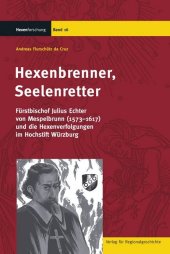 Neuerscheinungen 2017Stand: 2020-02-01 |
Schnellsuche
ISBN/Stichwort/Autor
|
Herderstraße 10
10625 Berlin
Tel.: 030 315 714 16
Fax 030 315 714 14
info@buchspektrum.de |

Andreas Flurschütz da Cruz
Hexenbrenner, Seelenretter
Fürstbischof Julius Echter von Mespelbrunn (1573-1617) und die Hexenverfolgungen im Hochstift Würzburg
2017. 256 S. 5 Farbabb., 15 SW-Abb. 24 cm
Verlag/Jahr: VERLAG FÜR REGIONALGESCHICHTE 2017
ISBN: 3-7395-1086-2 (3739510862)
Neue ISBN: 978-3-7395-1086-6 (9783739510866)
Preis und Lieferzeit: Bitte klicken
Vorwort - 7
1. Hin- und Einführung - 9
1.1 Das Phänomen ´Hexerei´ - 12
1.2 Julius Echter und die Hexenverfolgungen im Hochstift Würzburg - 31
1.3 Forschungsüberblick - 36
1.4 Quellen - 42
1.5 Konzeptuelle Vorüberlegungen - 45
2. Die echterzeitlichen Hexereiprozesse: Akteure und Einflussfaktoren - 53
2.1 Klimatische und wirtschaftliche Einflüsse - 53
2.2 Julius Echters Herkunft und Familie - 60
2.3 Weltliche Beamte und Berater - 71
2.4 Geistliche Ratgeber - 95
2.5 Johann Gottfried von Aschhausen - 99
2.6 Weitere Nachbarfürsten und -territorien - 107
2.7 Die Bevölkerung - 128
2.8 Literarische Strömungen um 1600 - 138
2.9 Patrona Herbipolensis: Die Muttergottes - 146
2.10 Annäherung an einen frühneuzeitlichen Charakter - 151
2.11 Gegenreformation und Hexenverfolgung - 163
3. Julius Echter in den Quellen und in der Literatur - 174
3.1 Die Zwo Hexen Zeitungen und Jakob Röders Schreibkalender - 174
3.2 Weitere Quellenbefunde - 180
3.3 Der ´frühe´ und der ´späte´ Echter - 198
4. Zusammenfassung und Fazit - 204
5. Würzburger Hexereiprozesse nach Echter - 212
6. Abstract - 219
Quellen- und Literaturverzeichnis - 221
Personenregister - 239 / Ortsregister - 243 / Sachregister - 246
On est tout de suite séduit par la forme et la présentation de cette monographie: les nombreuses reproductions de documents d´archives alternent avec une riche iconographie d´époque. Attrayant, l´ensemble soutient et éclaire la rigueur de la réflexion. Le travail d´Andreas Flurschütz lève bien le flou qui occultait le rôle réel joué par le souverain de Wurtzbourg dans la répression de la sorcellerie. Il fournit un cadre complet permettant de saisir à la fois la personnalité de Julius Echter et son époque. En ce sens, on peut le considérer comme un excellent instrument de comparaison à mettre au service d´une réflexion globale sur la sorcellerie européenne, même s´il offre peu de perspectives novatrices. Jean-Claude Diedler, in: Francia-Recensio 2019/20
Prince Bishop Julius Echter von Mespelbrunn has often been charged with involvement in the witchcraft trials that took place mainly at the end of his life and reign. A new investigation suggest that the bishop, who has usually been regarded as one of the Franconian witch hunters, should be seen instead as someone who acted much more carefully regarding those accused of witchcraft. This is the first monograph to examine in detail the causes for the witchcraft trials during Echter´s long reign in the prince-bishopric of Würzburg (1573-1617), evaluating different factors and actors in these events, among whom the bishop was of course the most eminent but by no means the only one. The author shows that the main drivers of the craze were the local populations of specific towns and villages, even though their demands could only succeed in cooperation with members of the territorial, but mainly local elites.


